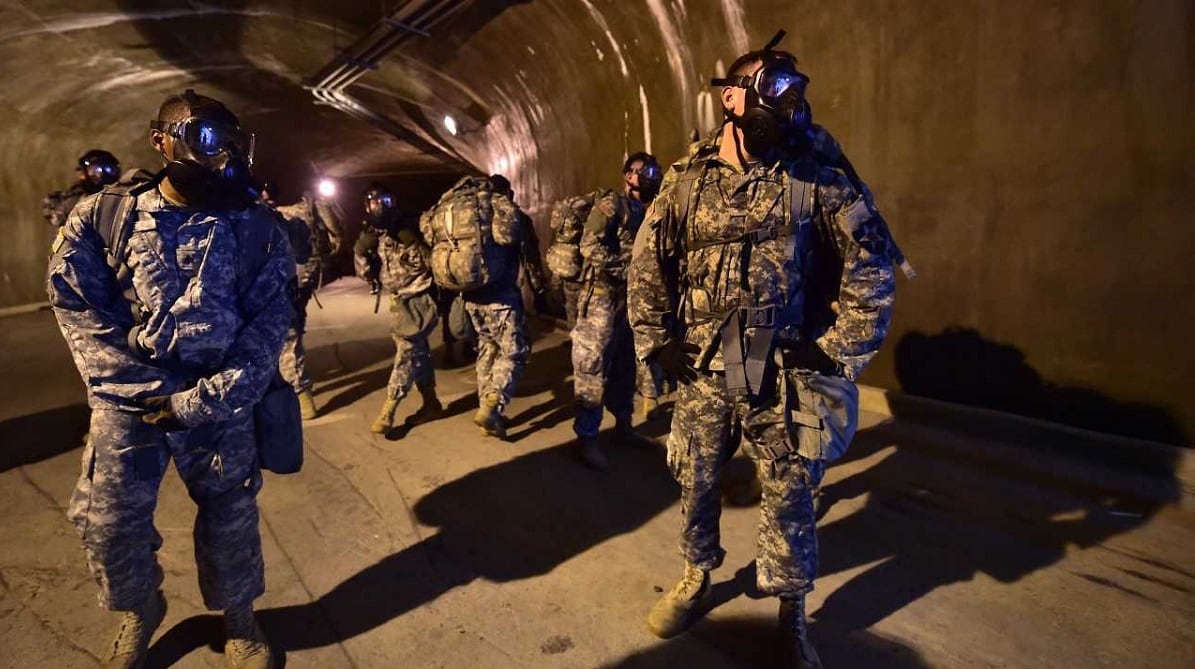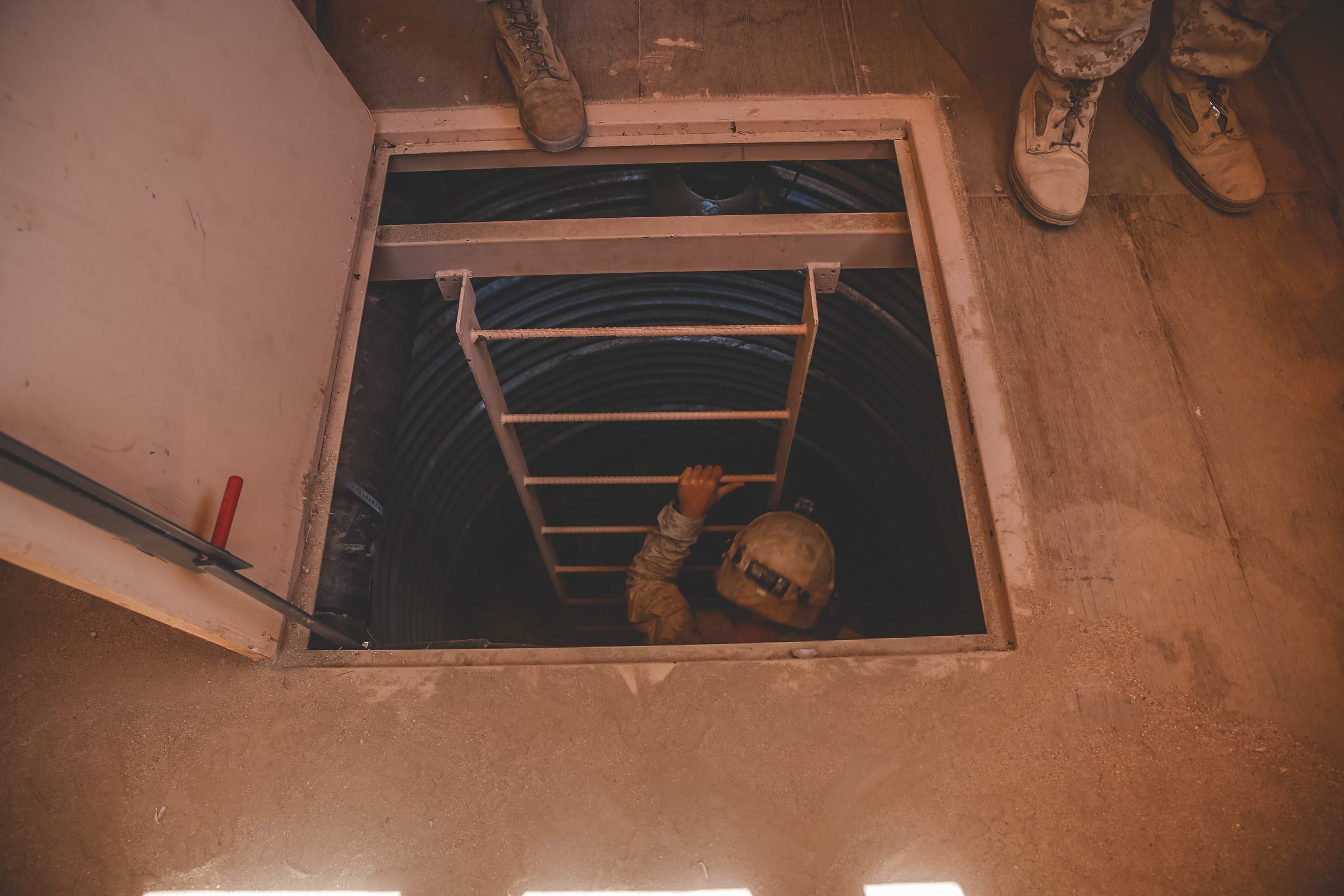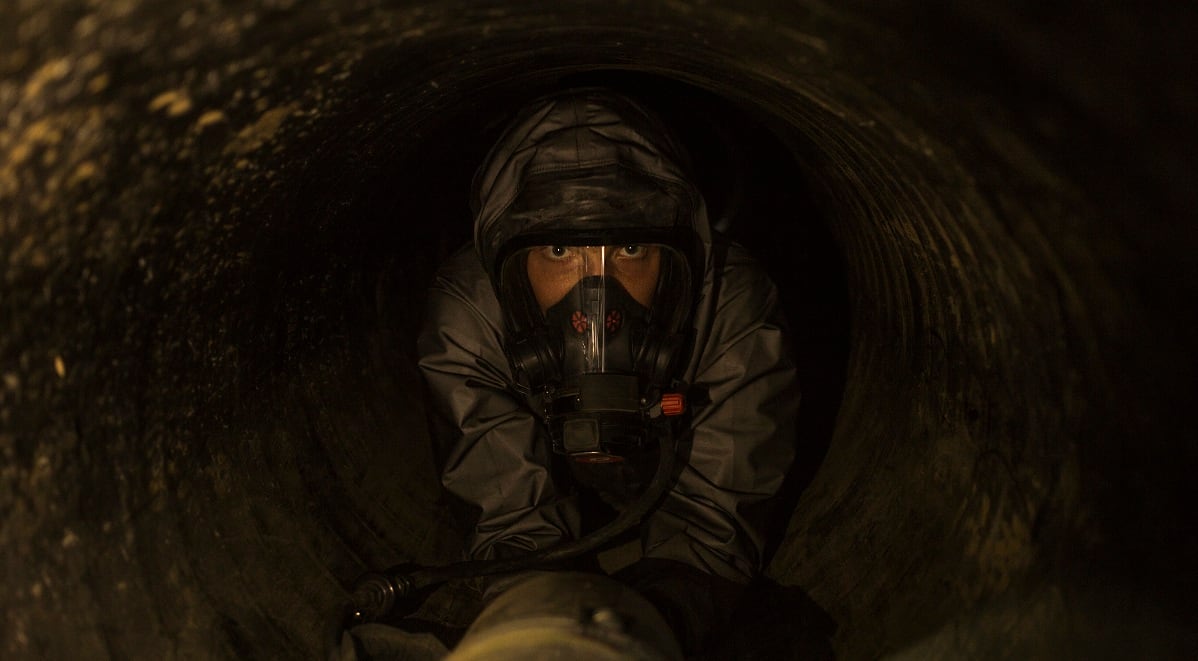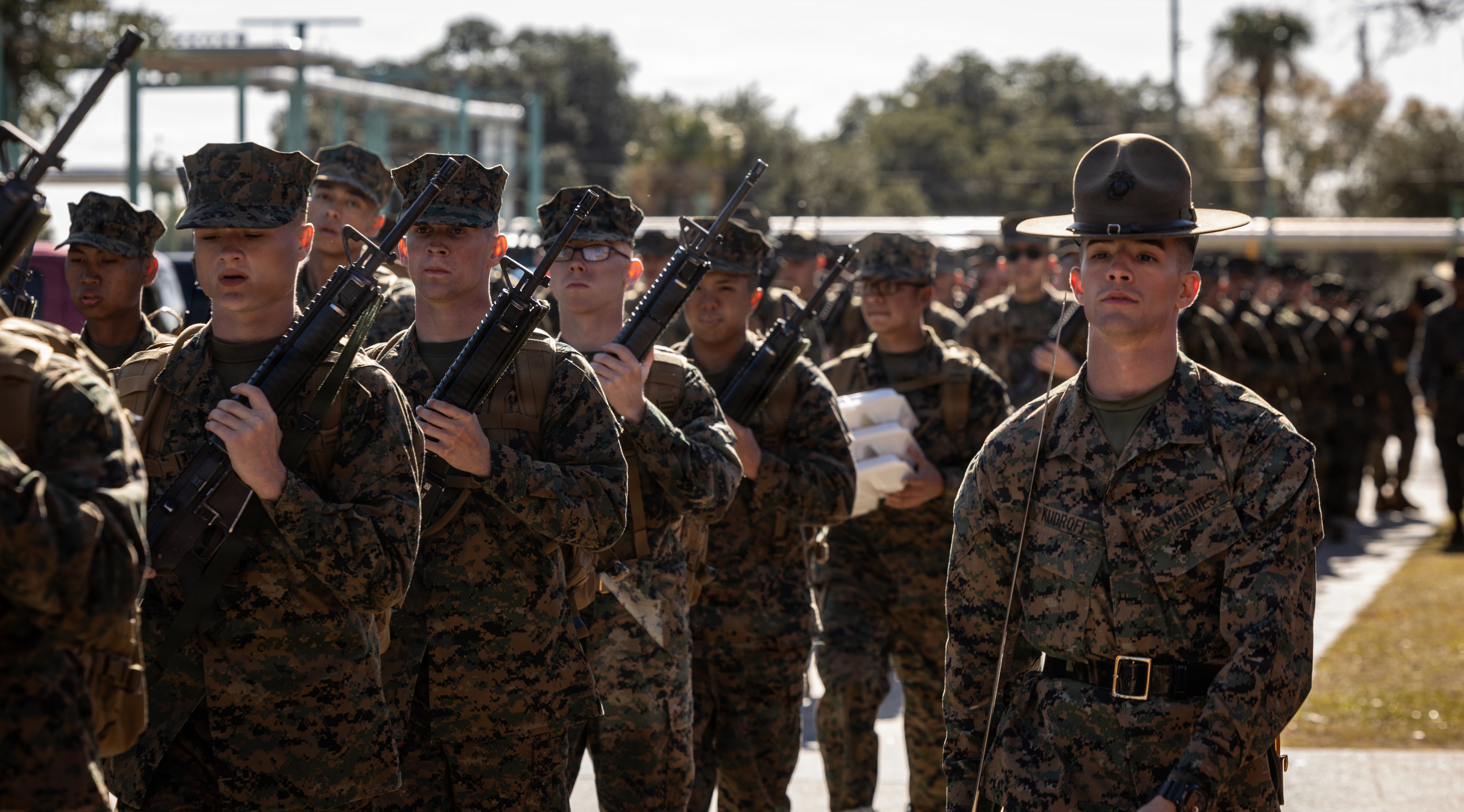FORT BRAGG, N.C. — It is darkness like you’ve never seen. The air you breathe could kill you in moments. All of your fire support — air, armor, artillery — is useless. The walls and ceiling could collapse. Communications will fail. A wrong turn leaves you utterly alone.
Going underground, in dark, tight spaces, can trigger feelings of helplessness in even experienced troops. It is the most primitive and close combat a fighter may face.
“You think you’ve been in a dark environment?” a former special operations soldier-turned trainer said. “Wait until you get into a deep underground facility and the power’s cut. That is scary.”
Welcome to the subterranean.
It is happening in Syria now. Iraqi forces faced it in Mosul. Russia, China, North Korea, Iran all boast complex facilities laced with reinforced command and control and the ability to deploy thousands of troops, tanks, missiles and even launch planes from underground runways.
As with guerrilla fighters in Vietnam, militant groups from Islamic State to Hamas to rebel groups in Africa have expanded their use of the underground, whether in remote caves or by burrowing their way through cities such as the city of Darayya, Syria, for what became tunnel-on-tunnel warfare with the regime.
“They’ve gone underground to match our overmatch,” said retired Army Maj. John Spencer, chairman of Urban Warfare Studies with the Modern War Institute at West Point.
In the Zhawar Kili complex, Navy SEALs encountered a cave system in the early days of the Afghan War. They thought it would take a day to clear. Nine days later they had searched 70 reinforced tunnels, destroying 50 of them, including 60 structures inside a facility that included a mosque, repair shops, a medical facility and communications center.
And that was far from civilian populations. Armies today do not have that luxury.
“I think it starts with the likelihood of warfare in a city,” said Dakota Wood, Heritage Foundation senior research fellow and retired Marine officer. “Almost all futures documents predict an urban environment wave.”
Nearly any city troops may enter tomorrow has mazes of sewers, telecommunications lines and subway tunnels beneath its streets, concealing untold threats.
They may vary in type and scope, but all underground terrain accomplishes a major feat: reducing, balancing, even negating U.S. military technological superiority.
Minor nods to underground training, from small tunnels or trenches used by opposing fighters at Army and Marine Corps training centers have been a feature for years. Serious manning, equipping, funding and training across the force has been lacking.
“From a mere tool of war, underground warfare has evolved into a global security threat of concern to all states,” Daphné Richemond-Barak wrote in her 2017 book, “Underground Warfare.”
The tactical
Marine Corps’ experts in underground fighting in Twentynine Palms, California, declined to be interviewed for this piece. Experts at their tactical operations group were involved in force-on-force training at the time of reporting and were unavailable for comment.
But news reports reference side-by-side tactical level underground training by Marines with Israeli counter-tunnel work and with Norwegian troops related to weapons stocks stored in massive caves to protect NATO against potential Russian aggression.
The Army is taking a multiprong attack to the threat. All those interviewed applauded it for the focus on a terrain that will surely plague commanders and troops.
At least two years ago, the Army assessed its underground combat capabilities and found gaps.
With knowledge gleaned from the battlefield and years of study it quickly updated manuals, pushed funding and deployed training teams with the Asymmetric Warfare Group with fighting know-how to spread the gospel across brigades.
This is driven by the Army’s vision for being prepared to fight in any terrain across the globe against near-peer threats and nonstate actors.
Top leadership has emphasized the need for troops to be ready to fight in megacities and the underground is a feature that cannot be ignored.
RELATED

“The bottom line is that the subterranean environment is really a facet of the infrastructure,” said Army Col. Timothy F. O’Brien, AWG commander.
Military Times spent nearly a week alongside soldiers of the 1st Brigade Combat Team of the 82nd Airborne Division at Fort Bragg, North Carolina, in early February for some of the initial training that AWG built for Army’s Maneuver Center of Excellence and is bringing to at least a reported 26 of 31 active brigade combat teams across the Army.
Officials did not confirm exact numbers of how many brigades have or will receive the training, but the goal is to spread the fundamentals across the force.
The paratroopers were getting hands-on experience from the tactical manual, “Small Unit Training in Subterranean Environments,” which was published in late 2017, updating training practices that had changed little since the early 1990s and even back to World War II.
O’Brien stressed that elements of subterranean have been included in training for years. Much of the company and below training conducted by the estimated 160 paratroopers at Fort Bragg consisted of building on standard infantry skills, such as room clearing.
But, AWG trainers, which include uniformed personnel and civilian contractors, many who served in special operations forces units, add on important details and layers of limitations that soldiers will face underground.
And those reached down to life necessities.
“If you can’t breathe, you can’t fight, always remember that,” was a repeated mantra one trainer drilled for soldiers dealing with clean air supply and chemical threats.
Trainer identities were withheld for security concerns.
Soldiers were shown types of breathing devices, specialized meters for detecting chemical and other threats. Some systems could keep an experienced soldier breathing for close to an hour. But panicked, shallow breathing can reduce that to half the time.
Tiny changes can make a big difference. While many seasoned soldiers may be used to shouting commands or physical bumping the soldier in front of them during tight, room-clearing exercises, the addition of gas masks may mean soldiers have to use exaggerated head nods or squeeze a soldier’s shoulder to signal what to do next.
While thermal devices are being fielded, they’re not with every soldier. Existing night vision needs some light to operate. Some options include carrying along light sources, but noise and light discipline are key entering an unexpected room, cave or stairwell.
Blinding light to stun the enemy can work both ways.
Paratroopers spent the week practicing door breaching techniques that included welding torches, battery-powered saws, winches and sledge hammers, battering rams and prying tools.
Even those small steps have to take into consideration the environment. Oxygen levels, other gases could mean small sparks will set off major explosions.
They then did walk-throughs at a mock urban site where building windows had been blacked out to simulate underground atmosphere.
Later, they practiced stages using gas masks, ballistic shields, small robots and military working dogs as enablers, night vision to shoot paper targets and force-on-force drills with simunitions.
Again, small considerations weighed heavily. The dogs must be acclimatized to the dark. Handlers and breachers need to scout with robots before sending in a dog. Booties or burn blankets are necessary to protect paws so that the dog doesn’t get injured in the first breach and is rendered useless.
Those smaller training steps culminated in an event in which platoon-sized groups ran through the entire order from door breaching to clearing buildings of three or more floors.
Much of the training was familiar, but with new limitations.
RELATED

“I was skeptical coming in, I’ll be the first to admit, because I’m thinking how much different is this from trench warfare? And how much difference are we seeing from (urban training)?” said Capt. Pat Harris, company commander for Bravo Company, 2nd Battalion of the 504th Parachute Infantry Regiment.
The training isn’t expected to make the soldiers experts in underground warfare, but to introduce the concepts and practices to get leaders thinking about what it will take underground.
Capt. George Fletcher, company commander of Bone Company, 1st Battalion, 504th Parachute Infantry Regiment, said that his main takeaway was focusing on communication.
For example, if his troops are inside a complex and can quickly tell him this only goes down two floors, then he knows how to distribute his soldiers.
“If they tell me this stairway is not stopping that tells me I have to call back to my higher headquarters and tell them that hey, this isn’t a company fight, this may be a battalion fight,” he said.
And the captain said he saw how he would need to prepare for new challenges.
“Do we have the assets to continue to run our sustainment?” he said. “That’s a scary thought. Going a mile into a tunnel with not a lot of sustainment because it’s not wide enough for a lot of vehicles to go down there.”
Ready to go underground
Though the Army and Marine Corps want troops ready to go underground, not every base has the facilities.
Those include the Tunnel Warfare Center in China Lake, California, Yuma Proving Grounds, Arizona; White Sands Missile Range, New Mexico; Fort Leonard Wood, Missouri; Fort Story, Virginia; Fort Hood, Texas; and Muscatatuck Urban Training Center, Indiana, likely the most complex of the list.
The Marine Corps has underground features at its urban training facility at Twentynine Palms, California.

A 2013 Naval Postgraduate School thesis paper, “The Enemy Below,” by four Army majors advocated for increasing and deepening subterranean training and noted seven cave systems at the National Training System at Fort Irwin, California that could be used.
Multiple sources noted that Army officials are considering plans to develop more complex, urban underground facets.
It may not need to be as demanding as some predict. Spencer pointed to the New York Fire Department’s Randall’s Island Fire Academy, which contains a seven-story building that can replicate all the challenges of a 100-story structure.
Until then, the method of surrounding soldiers to give them a tunnel-like feel will be to use existing buildings and to acquire old Conex boxes, weld them together to create narrow passages, officials said.
“Even if we don’t have a subterranean environment, we have ways of recreating that environment and ways of implementing that in the training as they get more advanced and get more comfortable in the training,” said one AWG captain.
Beyond tactical
While the training the paratroopers experienced sets the stage, more questions remain.
Army officials declined to discuss operational or strategic preparations and limited answers regarding brigade leadership-level considerations. One did acknowledge there is a battalion staff component to the training.
But experts interviewed agreed that the Army’s reluctance to discuss higher level planning and thinking made sense.
If the service has come up with solutions to the underground problem at those levels, they don’t want them revealed. If not, they don’t want that revealed either.
“I think the Army is in an interesting place where they’re beginning to have an opportunity to lift their head up and look at the horizon for potential threats,” Scharre said.
Spencer compared some of the thinking to what he has observed in his study of military urban focus: gaps in imagination.
RELATED

“Just like we get narrowly focused on urban by putting up a shoot house, if someone does get training on a subterranean event, they focus on a small tunnel,” he said.
Though those conditions exist, it’s likely soldiers and Marines will face a complex underground in major cities with communication lines and an unknown number of entrances and exits.
He would like to see battalion, brigade and higher staff incorporate subterranean in their planning and wargaming, not as an afterthought but as both an offensive and defensive aspect of the fight.
“We can over focus on the 2D aspect, I would want to get my hands on any mapping, old maps to get an idea of what’s the underground aspect,” he said.
A retired Marine Corps officer with more than a decade of special operations experience, told Military Times that what the Corps has provided in the past focuses mostly on the unit level and planning higher than battalion operations needs more focus.
The big picture
The underground threat has been growing, trending among U.S. adversaries for at least the past two decades.
And, as Richemond-Barak noted, the underground space is “drawing closer to civilians.”
Combat alone is an unnatural experience and each terrain offers its own versions of hell — from blasting desert sandstorms to freezing arctic mountains to creeping jungles that conceal threats.
But underground fighting is something special.
“It breaks everything we train,” Spencer said.
Richemond-Barak’s research reveals deeper realities.
“The ‘unknown factor,’ permeates virtually every aspect of anti-tunnel operations from the strategic level down to the tactical level, and even the technical level — and in degrees exponentially higher than in above ground operations,” she wrote. “Once inside a tunnel, a soldier is very much alone.”
The underground layer connects to the above ground fight, from controlling friendly forces moving above and below simultaneously to how to find the enemy.
Tunnels make it necessary “to remain alert not only to what is above and ahead of them, but also to what is behind and below them,” Richemond-Barak wrote.
“The realm of what they cannot see — the uncertainty and the unknown — expands dramatically. It is no longer sufficient for soldiers to secure the rear, as tunnels can emerge from anywhere,” she wrote. “Even for well-trained soldiers, the multidimensional aspect of the subterranean threat is not easy to handle.”
Todd South has written about crime, courts, government and the military for multiple publications since 2004 and was named a 2014 Pulitzer finalist for a co-written project on witness intimidation. Todd is a Marine veteran of the Iraq War.





